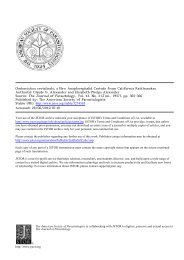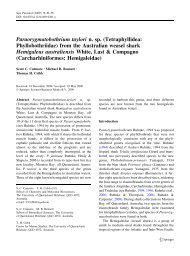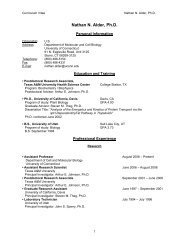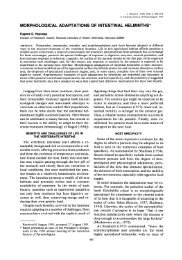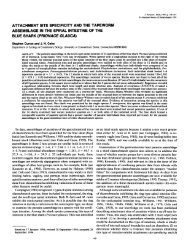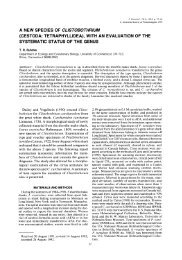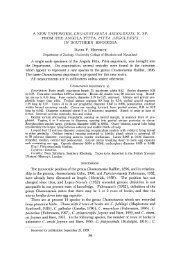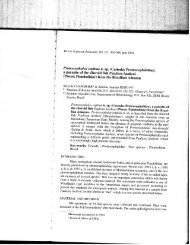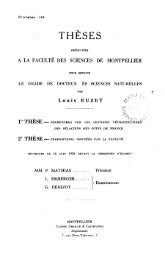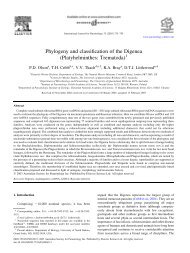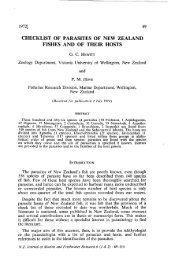The terminology of larval cestodes or metacestodes
The terminology of larval cestodes or metacestodes
The terminology of larval cestodes or metacestodes
Create successful ePaper yourself
Turn your PDF publications into a flip-book with our unique Google optimized e-Paper software.
26ticercoids’ generally possess a cercomer at some stage<strong>of</strong> their development but lack a ‘bladder’. <strong>The</strong> prefixsupposedly alludes to the primary lacuna (Wardle &McLeod, 1952), but this was not known at the timethat the name (‘lacuna primitiva’ <strong>of</strong> Grassi & Rovelli,1892) was applied by Leuckart (1876). Hence the etymologyis dubious. Likewise, ‘plerocercus’ scarcelydiffers from plerocercoid in meaning (Joyeux & Baer,1961), but also indicates a metacestode lacking a primarylacuna. <strong>The</strong> argument being developed here isthat several <strong>of</strong> the current, firmly entrenched termsf<strong>or</strong> <strong>larval</strong> <strong>cestodes</strong> are, from an etymological point<strong>of</strong> view, not completely appropriate, but are widelyaccepted. <strong>The</strong>ref<strong>or</strong>e, to argue f<strong>or</strong> the standardisation<strong>of</strong> nomenclature purely on etymological grounds ishazardous and could lead to increased confusion.An additional tradition is one in which metacestodenames ending in ‘–us’ (cysticercus, plerocercus)indicate the existence <strong>of</strong> a bladder, while names endingin ‘–oid’ indicate the absence <strong>of</strong> a bladder. However,no f<strong>or</strong>mal written presentation <strong>of</strong> this view canbe found! In the current re-arrangement <strong>of</strong> m<strong>or</strong>phologicalpri<strong>or</strong>ities, the presence <strong>of</strong> a bladder is <strong>of</strong> reducedsignificance, since it may be homoplasious, whilethe invagination <strong>or</strong> retraction <strong>of</strong> a scolex is acc<strong>or</strong>dedgreater significance than in the recent literature. Underthis system, cysticercus, a retained term, is appliedto meta<strong>cestodes</strong> in which the scolex is invaginated,while cysticercoid is applied to meta<strong>cestodes</strong> in whichthe scolex is retracted, although both have a primarylacuna <strong>or</strong> ‘cyst’ (sensu Wardle & McLeod, 1952).Procercoid and plerocercoid, which have either noscolex development <strong>or</strong> an everted scolex, have alsobeen retained as names f<strong>or</strong> <strong>larval</strong> <strong>cestodes</strong>. <strong>The</strong>ref<strong>or</strong>e,changing the name ‘plerocercus’ to a term ending in‘-oid’ to be consistent with cysticercoid, the othergroup name in which scoleces are retracted wouldeliminate one inconsistency, but would introduce anotherwith the entrenched term plerocercoid which hasan everted <strong>or</strong> invaginated scolex. Similarly, attemptingto find an alternative to ‘merocercoid’ f<strong>or</strong> <strong>larval</strong><strong>cestodes</strong> with inverted scoleces but lacking a primarylacuna presents obstacles since none <strong>of</strong> the existingnames (tetrathyridium, cladothyridium, cercoscolex)has a ‘−us’ suffix.<strong>The</strong> most parsimonious solution to this etymologicalmaze is to retain the tradition <strong>of</strong> ‘cyst-’ indicating(usually) the presence <strong>of</strong> a primary lacuna and ‘plero-’indicating the absence <strong>of</strong> a primary lacuna. <strong>The</strong> existingterm plerocercus can be used in place <strong>of</strong> merocercus,since this adequately covers both the encystedtrypan<strong>or</strong>hynchs and lecanicephalideans, and the comparableterm ‘merocercoid’ coined f<strong>or</strong> catenotaeniidsby Joyeux & Baer (1945) can be used f<strong>or</strong> tetrathyridia,cladothyridia and cercoscoleces, all <strong>of</strong> which lackbladders and are invaginated. Merocercoid favours no<strong>or</strong>der over the other and while not the older term,provides the greatest etymological unif<strong>or</strong>mity.In the final analysis, <strong>terminology</strong> represents findingcompromises between entrenched usage and etymologicalconsistency. <strong>The</strong> proposal suggested here isa compromise but seems to be an appropriate middlecourse between these two ideals, and will undoubtedlyattract criticism from either <strong>of</strong> the two possibleentrenched extreme positions.Based on the arguments presented above, thefollowing definitions are suggested f<strong>or</strong> meta<strong>cestodes</strong>identified on the basis <strong>of</strong> m<strong>or</strong>phological characteristics:Procercoid (Figure 4A) metacestode without scolexand primary lacuna, usually caudate, in which developmentcannot proceed until ingested by a secondintermediate host.Plerocercoid (Figure 4B) metacestode with (at leastpartial) scolex development (bothriate <strong>or</strong> acetabulate),scolex evaginated, non-lacunate, with <strong>or</strong> without cercomer,infective to definitive host.Merocercoid (Figure 4C) metacestode lacking a primarylacuna, in which scolex is invaginated, caudate<strong>or</strong> acaudate, usually without bladder (except inRhodobothrium, Phyllobothrium, Mon<strong>or</strong>ygma (Tetraphyllidea)).Plerocercus (Figure 4D) metacestode lacking a primarylacuna, in which scolex is withdrawn; caudate(disputed), with <strong>or</strong> without bladder.Cysticercoid (Figure 4E) metacestode with primarylacuna, scolex retracted,with cercomer <strong>or</strong> reduced cercomer.Cysticercus (Figure 4F) metacestode with primary lacuna,scolex invaginated, with <strong>or</strong> without cercomerand bladder.Within the two latter groups, cysticerci and cysticercoids,considerable m<strong>or</strong>phological diversity exists.Some within-group diversity can be indicatedsimply by the use <strong>of</strong> prefixes based on existing names.Cysticerci<strong>The</strong> terms utilised by Hoberg et al. (2000) have beenadopted. <strong>The</strong>se are:f<strong>or</strong> monocephalic cysticerci -cysticercus





